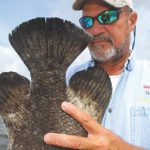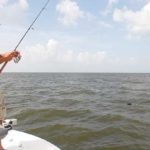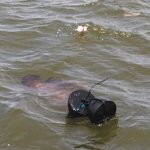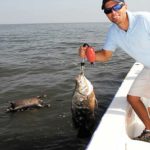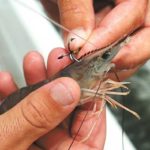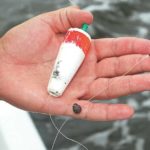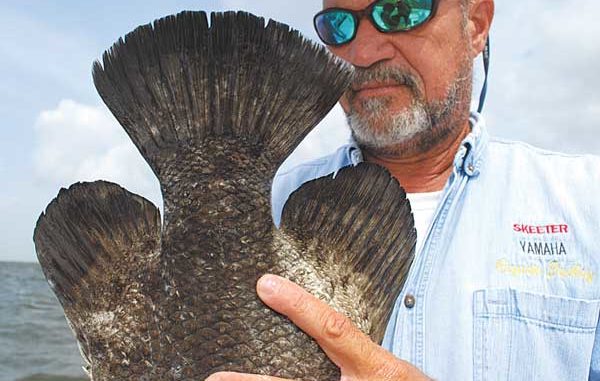
This sporting fish moves into Lake Borgne in remarkable numbers this time of year. It’s hard to determine which makes it more attractive — its fierce fight or its delicious fillets.
Some fish are cool; some aren’t. Even cold-blooded, dispassionate fisheries biologists recognize that.Sawfish are cool; pogies aren’t. Goliath grouper (known as jewfish in less politically correct times) are cool; black drum aren’t. Even a redfish isn’t too cool.
It’s hard to define what a cool fish is, but if you drew a picture of one, it would probably look like a tripletail.
Dudley Vandenborre Jr., 54, is a crusty veteran of the fish wars. In his nine years as a charter fishing guide and the 40 years he fished before that, he has racked up three 10-pound speckled trout and more than 50 9-pounders.
But if you want to hear unbridled enthusiasm in his voice, ask him about tripletail.
“They really excite me,” he said. “You get three things when you fish tripletail. You get to hunt, because we sight-fish them. You get to fish; they are strong-fighting fish. And you get great eating. I don’t eat much fish, but I eat tripletail.”
I was convinced.
“When are we going?” was my question.
“Be at my house in Slidell at 9 a.m. on Sunday,” was the reply.
Nine a.m.? Nine a.m.! Get outta here! Nine a.m. is when you leave for a picnic.
“The sun has got to be high enough so that you can see them,” he said. “You’ll see; just be here at 9 a.m.”
So, intrigued, after sleeping late and having a leisurely breakfast, I showed up at the instructed hour. Vandenborre and his 26-year old son Jesse had his boat out of its sling and ready to go.
“We’ve got one stop to make, at the Rigolets Marina, to get some live shrimp,” he said. “I’ve never seen a tripletail that can resist a live shrimp.”
The short ride to the marina was a little jouncy due to an unusually brisk August south wind, so I knew that the open waters of Lake Borgne were going to be tough. We were in the middle of a wet weather cycle, and for two weeks, a squall was always in sight in one direction or another, all day, every day.
On the run down Rigolets Pass to Lake Borgne, Vandenborre explained how he began fishing for this enigmatic fish.
“My son Jesse is a commercial crab fisherman who fishes a lot in Lake Borgne,” he said. “For a couple of years, he had been telling me about all the tripletails that were hanging around the floats on his crab traps in the lake.
“I just said, ‘Oh yeah?’ But he kept after me. Finally I did it the year before Hurricane Katrina, and I was hooked. I really got into it. Maybe it was the oddity factor.”
In the background, the bearded youngster had a huge grin smeared on his face.
“I kept seeing them while I was crabbing, so I tried to catch a few,” he said. “I spent more time fishing them than I did crabbing. It’s the temptation of seeing them.”
As we ran, the sun ducked behind some of the many clouds.
“I hope the sun comes back out,” young Vandenborre said.
His father explained further,
“We only cast to fish that we see,” he said. “On a good sunny day, we can see them as deep as 3 feet beneath the surface.”
The boat popped out into the choppy waters of Lake Borgne.
“We might get a little wet today,” Vandenborre said. “But we should still be able to see the fish.”
Jesse moved to the bow of the boat and stood erect beside the throne-like pedestal seat that his father usually occupies when he’s trout fishing. This day, he acted as spotter, and Dudley was the pilot.
At the first string of crab-trap floats, Vandenborre swung parallel to the line of corks and cruised down the irregular row about 15 yards from them. He kept the boat running at a speed just fast enough to keep it up on plane. Jesse’s young eyes scrutinized each float closely.
Suddenly, he turned to his father with a broad grin and pointed at a float. There, less than a foot beneath the surface was the shimmering black-and-silver outline of something that wasn’t near any of the other floats.
Vandenborre knowingly grinned back and directed the young man to take the first fish. He quickly impaled a hook under the horn on top of a big white shrimp’s head. The rig couldn’t have been simpler — a 20-inch heavy monofilament leader with a modest-sized treble hook on one end and a swivel on the other. An old-style foam popping cork was used to suspend the rig. A large split shot clamped on the leader completed it.
The young man deftly flicked the bait 7 or 8 feet past the fish, which was serenely floating just ahead of the crab-trap cork. When he retrieved enough line to bring the bait close to the fish, it languidly inhaled the shrimp.
Jesse set he hook and began the retrieve. The fish allowed itself to be towed in without resisting. That is, until it spotted the boat; then all the devil broke loose. It made a power run, stripping line off the screaming reel. Belying its bulky, cumbersome appearance, it next launched itself 3 feet out of the water, landing with a huge splash.
Then, like a great big freshwater bream, it turned its broad body sideways to the boat. It was almost impossible to budge. After two or three more runs, the elder Vandenborre finally slipped a landing net under the fish.
For such a clunky-looking fish, it was an impressive performance. It weighed 8.1 pounds.
With the fish on ice, the two men resumed their positions. Not too far down the line, another mirage-like image appeared. This one was brown and had its nose buried under the cork. Dudley took his turn, and the fish readily obliged.
But the stubborn fish quickly wrapped the fishing line around the stout rope of the crab trap. Before he got the fish disengaged, pieces of shattered popping cork were scattered on top of the water.
When the 5-pound fish was added to the ice chest, the first one, caught only a few minutes before, was a bright silver color.
“These things are like chameleons,” noted Dudley. “Sometimes they’re black, sometimes silver, or even green or brown. And they change colors so quickly.”
Things looked good. The two men’s objective was to catch four fish, two per person and they were halfway there.
But the next line of crab trap floats didn’t yield a fish. Neither did the next one.
“I wish that I could figure out the movement patterns of these fish,” Dudley muttered in a slightly exasperated tone. “You can’t really depend on tripletail being in any one particular place in Lake Borgne. They could be on any trap line. You just have to go in the lake and look at a lot of corks.”
But the fourth line of traps was good to the two men.
The next tripletail was another 8-pounder, which the two judged as good but not impressive. Jesse’s best is over 14 pounds and Dudley’s biggest is 21 pounds.
“They get a lot bigger, though,” averred Dudley. “Jesse saw one that he estimated would go at least 35 pounds a couple of years ago.”
“Yeah, I saw it everyday for several days, right next to a white PVC pipe sticking out of the water, and so I told Dad about it,” confirmed the younger man.
“When he told me about that fish, I went after it,” explained Dudley. “I burned 70 gallon of gas in one day looking for that fish, and I never even saw it.”
Obviously enjoying ribbing his dad, the young crabber said with a grin that he saw the monster again the next day, when his dad was on a charter trip.
As they chugged down the line in pursuit of their self-imposed limit of two fish each, Dudley explained what they look for.
“Obviously, you look to see the whole fish and a lot of times that’s what you see,” he said. “They are weird fish. They will just lay there on one side, right near the surface, floating next to a cork and kinda just looking around.
“But when they’re deeper, they’re harder to spot. You just see a reflection or a shadow. They’re hardest to see when they aren’t laying on their side and all you get is a view of the narrower back of the fish.”
Just as he finished his comments, Jesse spotted a fish in just that position. It was indeed tough to see. Dudley did his usual routine, which was to pass the cork with the fish, swing the boat wide and circle back to get into casting position.
But this one would have none of it. Seemingly unalarmed, it casually eased itself deeper and refused the presentation of the biggest shrimp in the livewell.
The next tripletail was positioned like the previous one, with its back toward the surface, and again it was hard to see. Worse, the boat caught a wave wrong and threw spray all over the fish.
After swinging the boat around, the fish was no longer on the surface. Still, they gave it a try, positioning the popping cork something over 3 feet deep. Down the cork went, and soon the men had their fourth and final fish in the boat. They were done at noon.
And not a moment to soon. To the northwest, the way back in, a wind-shift line was closing in on them. The water behind the line was covered with white caps. And ugly squalls were building in three different directions.
They had to head directly into the teeth of a muscular northwest wind. The vicious beating made it feel like my internal organs were being unhinged.
As if to console me, Vandenborre explained that some of the best times to fish tripletails were yet to come.
“Usually in late August and through September, the weather calms down some and fish numbers are up,” he said.
The younger man agreed.
“When I’m crabbing, I always see a lot of tripletail all the way up until the first serious cold front affects water temperatures,” he said. “Then they’re gone.”
Back at the Vandenborre dock in Eden Isles, Dudley set to the task of cleaning the broad-shouldered fish. Their flesh is beautiful — translucent and pinkish-white. As he cleaned the fish, he casually popped raw morsels of flesh, sashimi-style, into his mouth.
“Umm, they’re good,” he purred.
His wife Kim groaned in disgust.
“One thing about tripletail is that the big ones taste just as good as the little ones,” he said. “That’s kind of unusual. To me they’re like giant saltwater sac-a-lait.”
When he finished filleting the fish, the ever-curious man checked the stomach contents of the fish he had cleaned. Two of them had food in them. Two partially digested fish emerged from the first stomach. One was clearly identifiable as a pogie.
“Huh, I’ll bet he’s eating leftover bait that the crabber is emptying out of his trap,” Dudley speculated.
Pogies are very commonly used as crab bait.
The other stomach had two more partially digested fish, one of which was clearly not a pogie and both of which were from fish definitely too small to have been used as crab bait. The inspection produced more questions than answers.
Sitting in the shade with his wife after the fish were cleaned, Vandenborre mulled over the tripletail fishery. He was one of the first anglers and certainly the first fishing guide in the Pontchartrain/Borgne area to target tripletail, so he has seen the changes that have occurred in the fishery.
“When we first started fishing them, it was easy to see over a hundred fish a day,” he said. “Now a good day is 15 to 18. They’re so easy to catch. I don’t really think they are the smartest fish.
“They’re probably not in biological trouble, but I think it would be better for a lot of people to catch a few each, rather than have one really good fisherman catch a hundred. I’ve put myself and my clients on a two-tripletail-per-person limit.”
In spite of Vandenborre’s intense interest in the fish, he doesn’t accept charter trips strictly for tripletail.
“They’re too undependable,” he said.
He will, however, accept combination charters for speckled trout and tripletail.
Capt. Dudley Vandenborre can be reached at (985) 847-1924.
